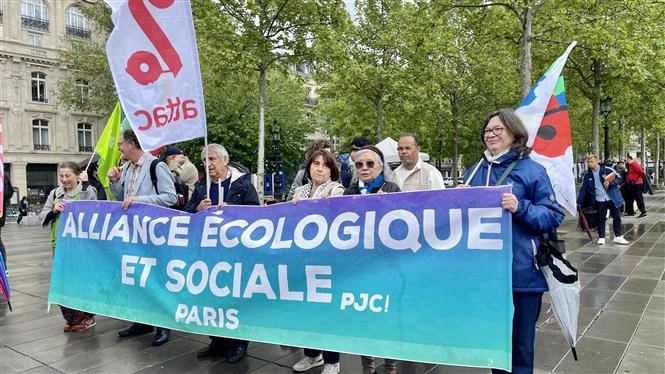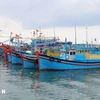
Hanoi (VNA) – More than 200 overseas Vietnamese and French friends gathered with various organisations at the Place de la République in Paris on May 4 to express their support for Vietnamese-French Tran To Nga and Agent Orange (AO)/dioxin victims of Vietnam in a lawsuit against chemical companies that supplied herbicides to the US military during the war in Vietnam.
The activity took place ahead of the May 7 hearing at the Paris Court of Appeals, which continues the trial of the 82-year-old woman's lawsuit against Bayer-Monsanto and 13 other companies that manufactured or marketed the AO/dioxin used by the US military during the war in Vietnam from 1961 to 1971. Facing these chemical industry giants, lawyers William Bourdon and Bertrand Repolt will defend Nga and millions of victims of this toxic substance in Vietnam.
Talking to the Vietnam News Agency’s correspondents, Vo Dinh Kim, the coordinator of the Collectif Vietnam-Dioxine association and a member of the support committee for Nga, said that the event received strong support from many environmental advocacy groups such as Greenpeace and Attaque, as well as representatives of various political parties and French citizens recognising the importance of her legal battle and wanting to show their solidarity with her action. Several French media outlets came to witness and report on the event, he added.
Kim expressed his hope that the court will consider and rule to acknowledge the struggle of the victims.
Sandrine Rousseau, a parliamentarian and member of the Europe Ecology – The Greens (EELV), stressed the importance of the lawsuit with a belief that it remains relevant today due to the ongoing consequences of Monsanto's production and distribution of the toxic chemical. She held that not only this corporation but also the entire pesticide and agrochemical industry have affected the health of many generations.
The lawsuit brought before the French court showed that Nga and millions of AO victims are not abandoned and do not have to endure this pain alone, she remarked.
Vice Chairman of the Vietnam Association for Victims of Agent Orange (VAVA) Nguyen Hong Son, who is in Paris to attend the trial, said the Belgian parliament has passed a resolution supporting the rights of AO victims and hoped that the French parliament will continue to accompany and support the Vietnamese victims in their struggle.
Excited by the presence of a large number of supporters at the event, Nga said this demonstrated the growing strength of justice.
Nga, born in 1942, graduated from a Hanoi university in 1966 and became a war correspondent of the Liberation News Agency, now the Vietnam News Agency. She worked in some of the most heavily AO/Dioxin affected areas in southern Vietnam such as Cu Chi, Ben Cat and along the Ho Chi Minh Trail, ultimately experiencing contamination effects herself. She suffered from five out of the 17 diseases, disorders, deformities, and malformations associated with dioxin exposure recognised by the US. Among her three children, the first child died of heart defects and the second suffers from a blood disease.
In 2009, Nga appeared as a witness at the Court of Public Opinion in Paris, France, against the US chemical companies.
On April 16, 2015, the Crown Court of Evry city in the suburb of Paris held the first hearing on the case, but since then, lawyers of the sued chemical companies tried every way to prolong the procedures.
On May 10, 2021, the Evry Crown Court rejected her lawsuit, saying it did not have jurisdiction to hear the case, a ruling that disappointed the Vietnamese and international public.
However, Nga and her lawyers decided to file an appeal, and the struggle for justice for AO/dioxin victims is still underway.
From 1961-1971, US troops sprayed more than 80 million litres of herbicides, 44 million litres of which were AO, containing nearly 370 kilograms of dioxin, over southern Vietnam.
As a result, around 4.8 million Vietnamese were exposed to the toxic chemical. Many of the victims have died, while millions of their descendants are living with deformities and diseases as a direct result of the chemical’s effects./.






















